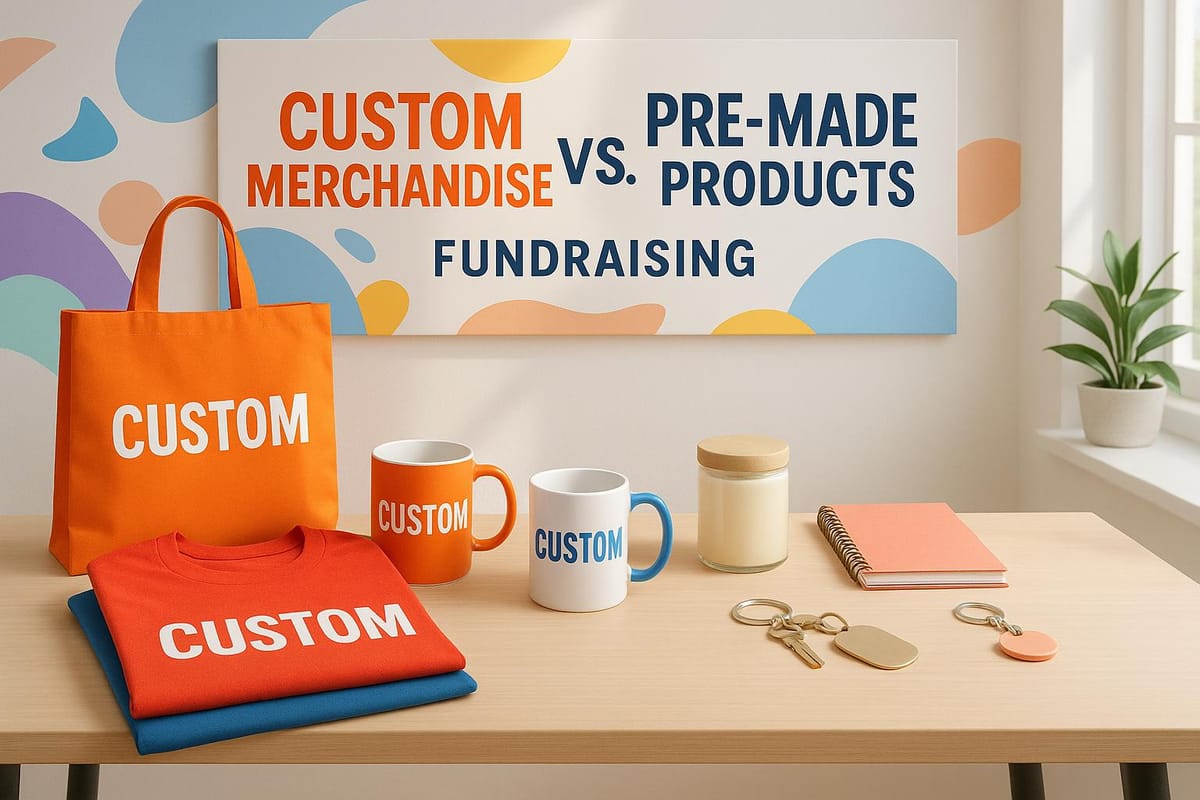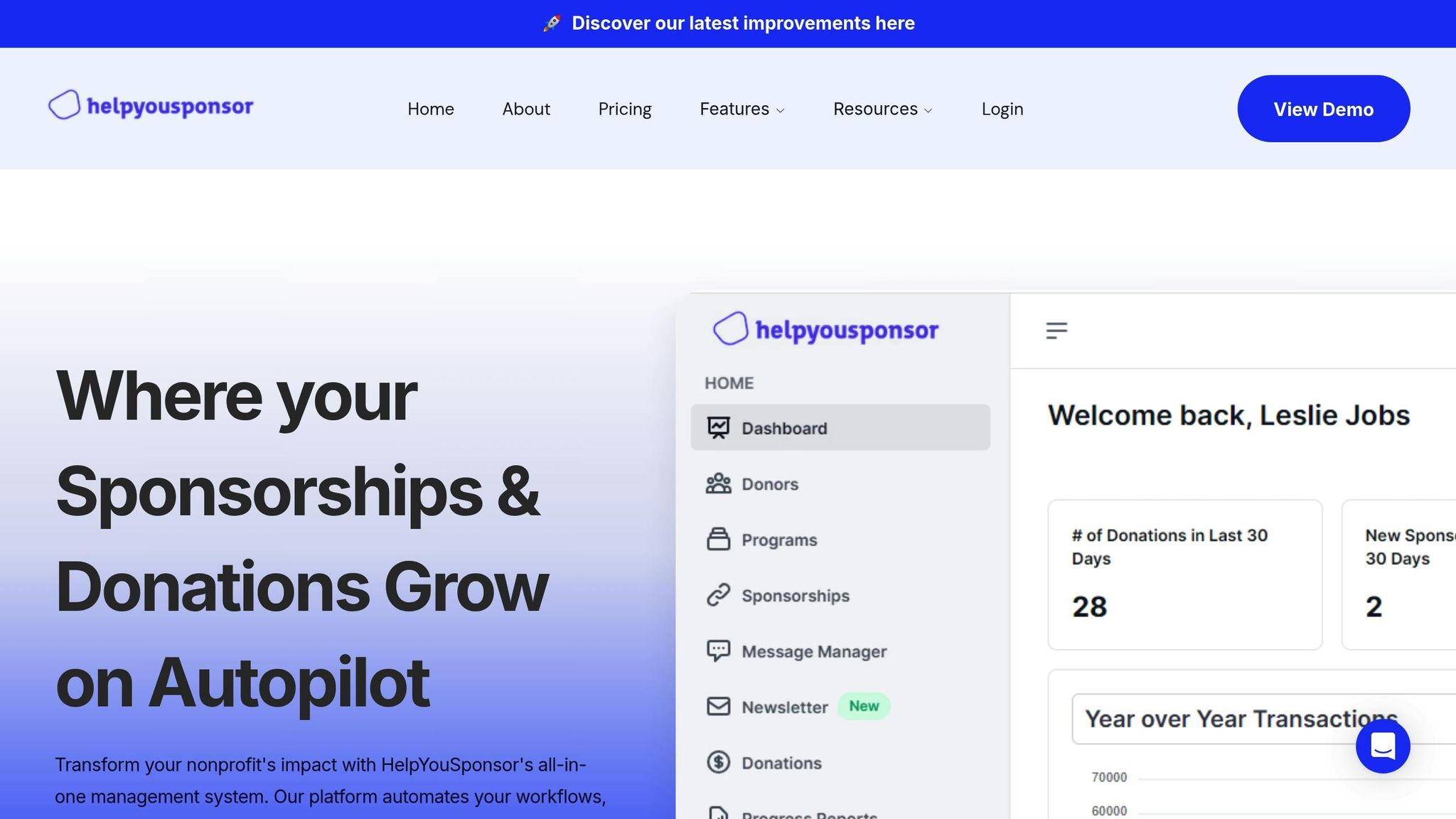Custom Merchandise vs. Pre-Made Products for Fundraising
Explore the advantages and challenges of custom merchandise versus pre-made products for effective nonprofit fundraising strategies.

Merchandise fundraising is a great way for nonprofits to generate funds while connecting with supporters. You can choose between custom merchandise (designed from scratch to reflect your organization’s identity) or pre-made products (existing items branded with your logo). Each option has pros and cons depending on your goals, budget, and timeline.
Key Takeaways:
- Custom Merchandise: Offers full design control and stronger branding but requires higher upfront costs, longer production times, and careful inventory management.
- Pre-Made Products: Faster and less expensive to start but offers limited customization and may risk oversaturation or unsold inventory.
Quick Comparison:
| Factor | Custom Merchandise | Pre-Made Products |
|---|---|---|
| Cost | Higher upfront investment | Lower initial costs |
| Timeline | Longer due to design/production | Shorter, ready-to-use items |
| Branding | Fully customizable | Limited personalization |
| Inventory Risk | Can use print-on-demand | Bulk purchasing risks leftover stock |
| Engagement | Builds stronger emotional ties | Relies on product appeal |
How to Decide:
Choose custom merchandise if you want to strengthen your brand and have the resources to invest in planning. Opt for pre-made products if you need a quick and cost-effective solution for short-term campaigns or testing new ideas. Both approaches can be effective when used strategically.
Tools like HelpYouSponsor can simplify managing merchandise campaigns, from tracking orders to automating tasks, helping nonprofits focus on building relationships and reaching their goals.
Insider Tips for Nonprofit Merch Fundraising Success
Custom Merchandise for Fundraising
Custom merchandise offers a tailored way to represent your organization. Instead of just stamping your logo on pre-made items, this approach allows you to design products from the ground up - choosing everything from materials and colors to messaging. This level of personalization ensures the items align perfectly with your mission and values.
Benefits of Custom Merchandise
Custom merchandise does more than promote your cause - it strengthens connections with supporters. According to a 2022 study by the Advertising Specialty Institute (ASI), 85% of people who receive branded promotional items remember the organization behind them for years. That’s a lasting impression you can’t afford to overlook.
Another major plus? These items stick around. A 2019 Global Ad Impressions Study found that promotional t-shirts alone generate at least 3,400 impressions during their lifespan. On average, people hold onto these shirts for about 14 months, and nearly half (47%) keep them for over two years.
"Custom merchandise and t-shirt fundraising do more than raise money; these are powerful branding tools for your next fundraising campaign", notes the Advertising Specialty Institute (ASI).
Beyond brand exposure, custom merchandise creates an immediate revenue stream. Each item essentially becomes a walking advertisement, spreading your nonprofit’s message far and wide.
But while the benefits are clear, custom merchandise comes with its own set of challenges.
Challenges of Custom Merchandise
One of the biggest hurdles? Upfront costs. Designing custom items, creating prototypes, and meeting minimum order requirements can quickly strain nonprofit budgets. Add to that the typical 3 to 6-week production timeline from design approval to delivery, and planning for time-sensitive campaigns becomes tricky.
Then there’s inventory management. Misjudging demand can leave you stuck with unsold items, tying up funds and storage space. On top of that, low-quality products can tarnish your reputation.
Pricing is another tricky area. For example, Shopify highlights that a 10% net profit margin is average, while 20% is considered high, and 5% is low. Striking a balance between affordability for supporters and profitability for your organization requires careful planning. Plus, managing sales and logistics takes time and resources, potentially pulling focus away from other effective fundraising strategies.
Lastly, nonprofits with limited brand recognition may face an uphill battle in generating enough sales to justify the investment in custom merchandise.
Best Use Cases for Custom Merchandise
Custom merchandise works best when it’s tied to specific initiatives or events that naturally drive demand. For instance, milestone campaigns - like celebrating anniversaries or major achievements - are perfect opportunities to create memorable, one-of-a-kind items.
Special events such as galas, charity runs, or community festivals are another ideal fit. Attendees already engaged with your cause are more likely to purchase merchandise, providing both immediate revenue and long-term visibility.
Custom merchandise can also play a key role in building your brand. This is especially valuable for newer organizations or those expanding into new areas. For example, one healthcare nonprofit distributed over 90,000 custom lanyards over three years, significantly increasing its visibility in hospitals and boosting brand recognition.
Additionally, offering exclusive, limited-edition items as part of donor appreciation programs can encourage higher contributions and foster loyalty. Awareness campaigns also benefit from custom merchandise by turning supporters into ambassadors for your cause. Practical, well-designed items not only communicate your message but also help spread it within the community.
Pre-Made Products for Fundraising
Pre-made products simplify the fundraising process by offering ready-to-use items. This approach skips the delays tied to design and production, making it a faster option compared to custom merchandise. Instead of focusing on creating products, you can concentrate your efforts on selling and distributing them.
Advantages of Pre-Made Products
One of the biggest perks of pre-made products is how little planning they require. You don’t need to worry about design approvals or long production timelines, and you can avoid the challenges of quality control altogether. These tangible items also double as effective marketing tools. Their visual appeal makes them perfect for promoting on social media or other platforms, helping you reach a wider audience. This strategy works across various channels, including in-person events, online stores, and peer-to-peer sales.
Take the Girl Scouts, for instance. Their peer-to-peer cookie sales generate over 200 million boxes sold annually, making it one of the most successful fundraising programs in the U.S.. Another example is Columbus Torah Academy, which raised funds by selling pre-ordered pizzas for $18 each before an event. They boosted their revenue further by continuing sales during the event itself. While these examples highlight the potential of pre-made products, it’s important to consider the challenges that come with them.
Disadvantages of Pre-Made Products
Despite their ease of use, pre-made product fundraisers aren’t without issues. One major risk is the upfront cost of purchasing items without knowing how well they’ll sell. This can lead to financial losses and unsold inventory. Another challenge is market saturation. When multiple groups run similar fundraisers, supporters might feel overwhelmed, resulting in “fundraiser fatigue.” This often forces organizations to rely heavily on personal networks, which may not always be sustainable.
There’s also the concern that focusing too much on selling products could overshadow your organization’s mission. Some parents and community members have expressed frustration with fundraisers that feel wasteful or overly commercial. Safety concerns, especially with door-to-door sales, add another layer of complexity. Parenting writer Samantha Kemp-Jackson highlights this contradiction:
"We tell our children repeatedly not to talk to strangers…now we are telling our kids to give candy to a stranger, and also give them our blessings in the process."
Additionally, offering items that don’t resonate with supporters can lead to wasted inventory and dissatisfied donors.
Ideal Scenarios for Pre-Made Products
Pre-made products shine in situations where speed and simplicity are key. They’re great for last-minute campaigns, seasonal fundraisers, or as an additional revenue stream. This approach also works well for testing new ideas with minimal risk. Seasonal fundraisers, such as those featuring holiday-themed items, back-to-school supplies, or summer treats, can be particularly effective - provided there’s enough time for the products to arrive before the season ends.
Comparison: Custom Merchandise vs. Pre-Made Products
Deciding between custom merchandise and pre-made products depends on your budget, timeline, and fundraising goals. Custom merchandise allows for complete personalization and helps build your brand over time, while pre-made products offer a quicker, more cost-effective approach.
Comparison Table: Key Factors
| Factor | Custom Merchandise | Pre-Made Products |
|---|---|---|
| Upfront Costs | Usually demands higher initial investment for design and production | Lower startup costs by purchasing ready-to-use inventory |
| Timeline | Takes more time due to design, production, and delivery processes | Products are available quickly, enabling faster implementation |
| Branding Potential | Fully customizable to showcase your organization’s unique identity | Limited customization options |
| Inventory Risk | Print-on-demand options can minimize inventory risk | Often requires bulk purchasing, which may lead to excess inventory |
| Supporter Engagement | Personalized items can create stronger emotional connections | Relies on the product’s inherent appeal and quality |
| Marketing Impact | Serves as a unique promotional tool for your cause | Offers standard promotional value with less emphasis on individuality |
| Setup Complexity | Involves more planning, including design and vendor coordination | Easier setup with ready-made products from established suppliers |
How to Choose the Right Option
The table highlights the key differences, but choosing the best fit for your campaign depends on your specific needs. Start by evaluating your budget, timeline, and main fundraising objectives.
If you have the resources and time to invest, custom merchandise is a great choice for building long-term brand awareness. Personalized items can significantly enhance donor engagement - studies suggest that personalized appeals can boost response rates by as much as 82%. Custom products allow supporters to feel connected to your cause, turning them into enthusiastic advocates. For instance, offering merchandise that reflects your organization’s identity, like branded apparel or unique accessories, helps spread your message far and wide.
On the other hand, pre-made products are ideal for campaigns that require a quick launch, have limited funds, or serve as a test for merchandise fundraising. These products are especially effective for seasonal or urgent campaigns where time is critical. Think about your audience’s preferences - college students, for example, might appreciate tech accessories like laptop cases, while families may favor practical items like water bottles or tote bags. A 2024 Jamf survey revealed that 40% of college students use Macs, making tailored tech accessories particularly appealing for education-related initiatives.
Budget constraints are another important factor. Platforms like Bonfire offer print-on-demand services, which eliminate upfront costs by producing items only after orders are placed. This approach can be a game-changer for organizations with tight timelines or limited funding, making pre-made products a safer, faster option for generating revenue.
In short, your choice boils down to your priorities. If you’re aiming for immediate revenue with minimal risk, pre-made products are the way to go. But if you’re focused on building a lasting brand presence and deeper supporter connections, custom merchandise is worth the investment.
Using HelpYouSponsor for Merchandise Fundraising

When it comes to running a successful merchandise fundraising campaign, having the right tools can make all the difference. Whether you're offering custom-designed products or pre-made items, managing the campaign effectively is essential for boosting sales, engaging donors, and tracking progress. That’s where HelpYouSponsor comes in - it simplifies merchandise-based fundraising by giving nonprofits the tools they need to handle both types of campaigns with ease.
Gone are the days of juggling spreadsheets and manually tracking orders. HelpYouSponsor centralizes everything - orders, donor details, and campaign progress - into one streamlined system. And the results speak for themselves: organizations using HelpYouSponsor have increased sponsorships by an average of 3.8x, with the platform currently managing over $19 million in donations. This centralized approach lays the groundwork for the platform's powerful features.
HelpYouSponsor Features for Merchandise Fundraising
One standout feature is the donor management system, which becomes especially useful during merchandise campaigns. Every interaction - from a donor purchasing a custom t-shirt to follow-up communications - is automatically logged into a centralized database. This creates a treasure trove of information for future outreach and engagement.
The platform also includes automated communication tools that handle time-consuming tasks like sending emails, issuing receipts, and scheduling follow-ups. According to HelpYouSponsor, these tools eliminate 90% of routine tasks, freeing up your team to focus on more strategic efforts.
For payments, HelpYouSponsor integrates with Stripe, ensuring smooth, hassle-free transactions for both individual and bulk purchases. Plus, it supports recurring donations, which can be a game-changer if your campaign involves subscription boxes or seasonal product releases.
Another useful feature is the custom form builder, which lets you collect exactly the data you need for your campaign. For example, if you're selling custom merchandise, you can gather sizing, color preferences, or personalization details. For pre-made items, you could ask donors about their motivations or request product feedback. All this data syncs directly with the donor database, ensuring nothing slips through the cracks.
The platform’s real-time reporting and analytics give you immediate insights into your campaign’s performance. You can see which products are flying off the shelves, identify your most engaged supporters, and track revenue against your goals. Customizable dashboards let you focus on the metrics that matter most, whether that’s units sold, average order value, or donor retention rates.
Increasing Revenue and Engagement
By automating routine tasks, HelpYouSponsor allows your team to focus on what truly matters: building relationships with donors and developing creative fundraising strategies. With the extra time, you can brainstorm new merchandise ideas, expand your campaign’s reach, or strengthen connections with your supporters.
The platform’s integrated messaging system helps you maintain ongoing communication with donors, turning one-time buyers into long-term advocates. Share impact stories, update supporters on how their purchases are making a difference, and invite them to join other fundraising efforts. This keeps your mission front and center, fostering deeper connections.
For organizations running multiple campaigns - like custom-branded items for an annual gala alongside pre-made products for a holiday fundraiser - the platform’s multi-program support is a lifesaver. It tracks each campaign separately while providing a consolidated view of your overall performance, making it easier to manage everything in one place.
The self-service portal is another standout feature. Donors can update their shipping information, check order statuses, and access their donation history without needing staff assistance. This is especially helpful during busy campaign periods when inquiries tend to spike.
Finally, the platform offers flexible pricing plans, including free and usage-based options, to accommodate nonprofit budgets. It also integrates seamlessly with popular tools like Mailchimp, Zapier, and QuickBooks, creating an efficient ecosystem that supports your entire fundraising operation - not just merchandise sales.
Conclusion
Selecting the right merchandise option depends on your organization’s goals, timeline, and budget. Both custom and pre-made merchandise play vital roles in nonprofit strategies, and knowing when to use each can mean the difference between a campaign that just breaks even and one that significantly boosts revenue.
Custom merchandise stands out when you have the time and resources to create something that truly reflects your mission. While it requires more planning, it delivers items that leave a lasting impression on your supporters. On the other hand, pre-made products are perfect for quick-turnaround campaigns, making them ideal for urgent fundraising needs or when working with tighter budgets. Striking the right balance between these options can lead to meaningful fundraising results.
Branded merchandise doesn’t just raise funds - it also strengthens your connection with your community. Research shows that 71% of people are likely to purchase a product they find useful, and 43% are motivated to buy simply to support the organization. Even better, 58% of individuals report that receiving branded merchandise positively influences their perception of a brand. This means your merchandise can do double duty: generating revenue while building goodwill.
To maximize these benefits, effective campaign management is key. Tools like HelpYouSponsor can simplify the process by tracking orders, managing donor relationships, and automating time-consuming tasks. Every item sold becomes a vehicle for spreading your nonprofit’s message to a broader audience.
Many successful nonprofits combine both approaches - using custom merchandise for major campaigns and donor appreciation, while relying on pre-made products for quick fundraising efforts and community events. By understanding the strengths of each option and leveraging the right tools, you can turn your merchandise into a steady revenue stream and deepen your connection with your supporters.
FAQs
What are the best ways for nonprofits to reduce inventory risks when using custom merchandise for fundraising?
Nonprofits can manage inventory risks tied to custom merchandise by taking a thoughtful and data-driven approach. Begin by reviewing past sales trends to estimate demand accurately. This helps avoid overordering, which can result in surplus stock that’s hard to move.
Keeping precise and current inventory records is equally important. It allows you to monitor stock levels closely and reorder items as needed without delays. Another smart strategy is to start small - place smaller initial orders or use pre-orders to measure interest before committing to larger production runs. This way, you can reduce waste and limit financial exposure.
How can organizations make pre-made products appealing to supporters while avoiding fundraiser fatigue?
To make pre-made products appealing to supporters and avoid fundraiser fatigue, it's essential to focus on meaningful engagement and offering variety. Start by personalizing your communication - share compelling stories that show exactly how the funds will be used. This helps supporters feel emotionally connected to the cause.
Another key strategy is to switch up your product offerings regularly. Introducing new items keeps things interesting and avoids the monotony that can lead to waning interest.
Don't forget to show your gratitude. A heartfelt thank-you note or a public acknowledgment can go a long way in making supporters feel appreciated. Providing clear updates about the fundraiser’s progress and the impact of their contributions also fosters a sense of achievement and motivates continued involvement. These thoughtful approaches not only sustain enthusiasm but also strengthen long-term loyalty.
What are the long-term effects of choosing custom merchandise versus pre-made products on a nonprofit's branding and supporter engagement?
Choosing between custom merchandise and pre-made products can shape your nonprofit’s branding and the way supporters connect with your mission. Custom merchandise allows you to design unique, branded items that reflect your values and story. These personalized products don’t just stand out - they help deepen emotional ties with your supporters, making them feel like an active part of your mission. Over time, this can build stronger loyalty and a more dedicated community.
On the flip side, pre-made products are often faster and less expensive to roll out. While convenient, they lack the personal touch that can make your supporters feel truly connected to your cause. If your goal is to create lasting engagement and a stronger sense of identity, custom merchandise tends to be the better option, especially when it aligns closely with your nonprofit’s vision and narrative.

